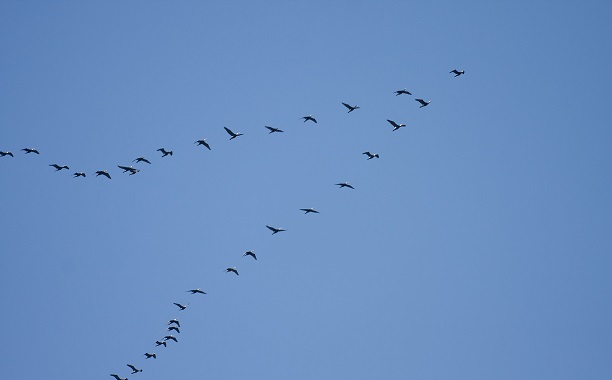The northern bald ibis flies in a V-shaped formation and a new study lead by Bernhard Voelkl, a biologist at the University of Oxford, indicate that the birds take turns leading the flock.
Voelkl recently published a prior study in the journal PNAS which indicated that the hermit ibis flies in a V in order to surf on one another’s air currents through precisely synchronized wing beats, Los Angeles Times indicated in a report published last month.
In regards to the question of why birds fly in a V, an evolutionary biologist at Rutgers University who was not involved in the study, Robert Trivers, said that he’s “been waiting for 40 years for someone to solve this problem,” LA Times reported.
I’ve been waiting for 40 years for someone to solve this problem […] V-formations are very, very obvious. They cannot be accidental and they cannot be trivial, because the birds do them. They do them all the time.
The toughest job in the endangered bird’s migration is taking the lead, as the lead bird does not receive assistance from any of the other birds in the fleet. In order to find out how the birds decide just who takes the toughest spot in the group, scientists worked with Austrian-based conservation group Waldrappteam to equip a flock of 14 young ibises with data-gathering precision GPS monitors to track where they were in relation to other birds.
Not a single bird took the spot at the head of the formation for an extended period of time, instead switching with one of the next birds in the formation after as little as just a few seconds; typically, the lead bird holds the position for less than a minute.
Voelkl indicated that during a one-hour flight, each bird would execute a pair-switch with its closest neighbor an average of 57 times and on a typical flight, which might last around three to eight hours, each bird would perform hundreds of transitions. The transitions take roughly a second to perform.
When it comes to leading the flying V, the LA Times quoted Voelkl as having said that “all of the birds (Geronticus eremtia) contribute almost equally” and that this discovery came as a surprise.
All the birds contribute almost equally to the investment in leading the flock […] This was surprising to us.
Are you surprised to learn why researchers believe the endangered northern ibises fly in a V-formation and take turns at the vertex of the flying V?
























